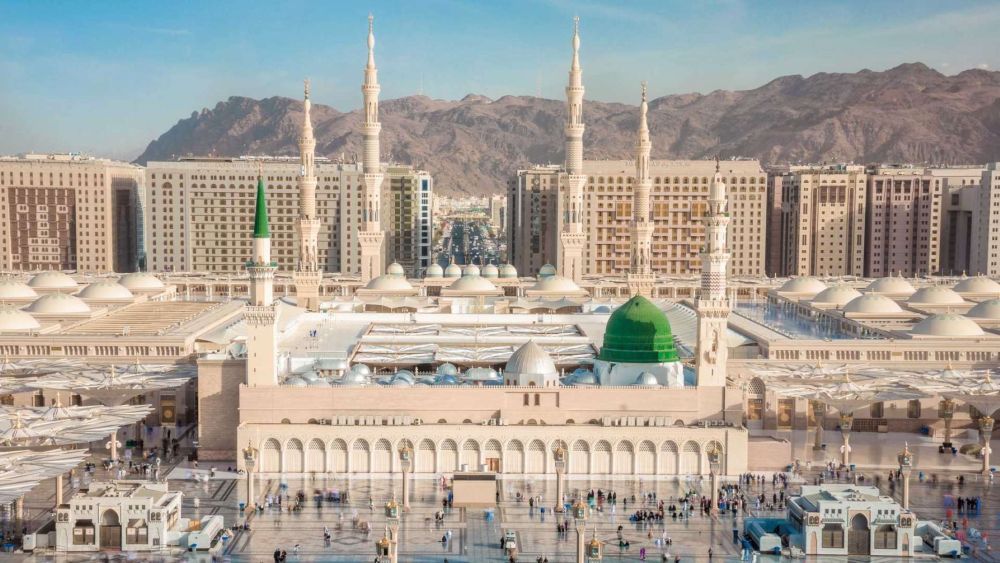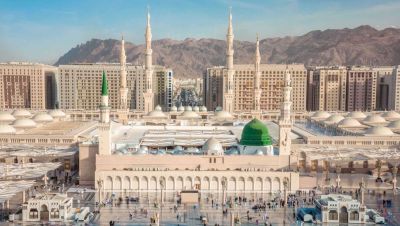

Ziyarah or a visit to Al-Masjid an-Nabawi is a spiritual and transformative experience. Al-Masjid an-Nabawi, the second holiest site in Islam, is the mosque that was established and originally built by the Prophet Muhammad (PBUH) in Medina. A visit to this mosque offers Muslims a chance to connect with their faith and the history of Islam. Pilgrims often come here to offer prayers, especially the highly meritorious Salat al-nabawiyy or prayer of visiting the Prophet, and to visit the Rawdah, which is considered a part of paradise on earth. The mosque is also the final resting place of the Prophet Muhammad (PBUH), and visiting his grave is an essential part of the Ziyarah, carried out with respect and reverence. The mosque has expanded vastly over the years and now includes a large open area for prayer, numerous minarets, and the Green Dome under which the tomb of the Prophet Muhammad (PBUH) lies.
Riyadh al-Jannah translates to 'Garden of Paradise' and is a small area within Al-Masjid an-Nabawi that extends from Muhammad's grave to his pulpit. Pilgrims strive to pray in this area as the Prophet Muhammad (PBUH) mentioned that the space between his house and his pulpit is one of the gardens of paradise. Practicing Muslims believe that prayers offered in Riyadh al-Jannah are of immense reward and that it is a place of great blessing. The area is distinctively carpeted in green and can be quite crowded. Timing your visit and having patience is essential due to the significant number of people wishing to pray here. Women have specific times that they can visit Riyadh al-Jannah, often after Fajr and Isha prayers.
While in the vicinity of Al-Masjid an-Nabawi, many pilgrims make the journey to Quba Mosque, which is located in the outskirts of Medina. It is the first mosque in Islamic history, built by the Prophet Muhammad (PBUH) himself upon his migration to Medina. Muslims believe that performing two Rakahs of nafl (voluntary prayer) at the Quba Mosque is equal in reward to performing one Umrah. The mosque features impressive Islamic architecture, and its tranquility offers a peaceful setting for reflection and prayer. Its origins and connection to the Prophet Muhammad (PBUH) make it a site of historical and religious significance for visitors.
Located near the Al-Masjid an-Nabawi, the Exhibition of the Two Holy Mosques Architecture is a museum that documents and showcases the historical and architectural evolution of the Grand Mosque in Mecca and Al-Masjid an-Nabawi in Medina. The exhibition is educational, providing visitors with a thorough understanding of the development and expansion of these two holy sites. It features models, photographs, and manuscripts, along with various artefacts related to the two mosques. The exhibition is enlightening for anyone interested in Islamic history, architecture, and the profound significance of the holy sites. It offers guided tours to enhance visitors' understanding of the sacred places' centuries-old history.
Al-Masjid an-Nabawi is not only a place for prayer but also a center for Islamic learning. Numerous scholars deliver lectures and hold religious classes within the mosque on various facets of Islam, including jurisprudence (Fiqh), the sayings of the Prophet (Hadith), and the interpretation of the Quran (Tafsir). These classes are open to the public and are a great way to enhance one's knowledge and understanding of the religion, often facilitated with translation in multiple languages. Attending a class or lecture can be a deeply enlightening experience, providing spiritual edification and scholarly insights.
Experiencing the evening prayer (Maghrib) followed by a short sermon on Thursdays in Al-Masjid an-Nabawi is a practice that many Muslims aspire to. The mosque fills with worshippers as the day ends, attending the Maghrib prayer, which is one of the five mandatory prayers for Muslims. Following the prayer, a sermon is often given by one of the scholars or imams, offering valuable lessons and reminders pertinent to Islamic teachings and daily life. The ambiance during this time is peaceful and contemplative, and being part of this communal prayer is a deeply moving and spiritual experience for believers.
Attending the congregational Fajr prayer at Al-Masjid an-Nabawi is a spiritually enriching routine. Muslims believe that starting the day with Fajr prayer in congregation brings blessings and peace. Al-Masjid an-Nabawi, with its serene atmosphere in the early hours before dawn, offers a unique setting for this daily ritual. The calm and devotion present at this time provide an opportunity for personal introspection and spiritual growth. As one of the pillars of Islamic practice, the Fajr prayer is a testament to the faith and dedication of those who attend, and it is a humbling experience to join the multitude of worshippers in prayer at one of Islam's holiest sites.
Al-Masjid an-Nabawi offers Zamzam water, which is considered sacred in Islam, to visitors through various water coolers and dispensers located throughout the mosque. The Zamzam well in Mecca is the source of this water, and it has historical significance as it is believed to have been miraculously provided to Hagar, the wife of Prophet Abraham, and her son Ishmael. Pilgrims often drink Zamzam water for its spiritual significance and supplicate for blessings. The water is available throughout the mosque for free, and it is quite an experience to follow this tradition carried out by millions of pilgrims every year.
The Islamic Calligraphy Exhibition near Al-Masjid an-Nabawi is a splendid place to admire the art of Islamic calligraphy, which plays a significant role in Islamic culture. Visitors can view beautiful inscriptions and artworks featuring verses from the Quran and sayings of the Prophet Muhammad (PBUH). The exhibition is a testament to the skill and craftsmanship of calligraphers who have preserved this art form over centuries. On display are various styles of calligraphy, including Kufic, Naskh, and Diwani, that have adorned mosques and Islamic texts throughout history.
Visiting Al-Masjid an-Nabawi during the night offers a unique perspective of the mosque, as the courtyard and minarets are beautifully illuminated. The cooler night air brings a peaceful ambiance perfect for reflection. Worshipers gather not only for the nightly prayers but also to recite the Quran, perform additional voluntary prayers (Tahajjud), or simply sit and soak in the tranquil environment of one of Islam's most significant places. During the month of Ramadan, the mosque becomes an even more focal point of worship, with additional Taraweeh prayers performed after the Isha prayer.
